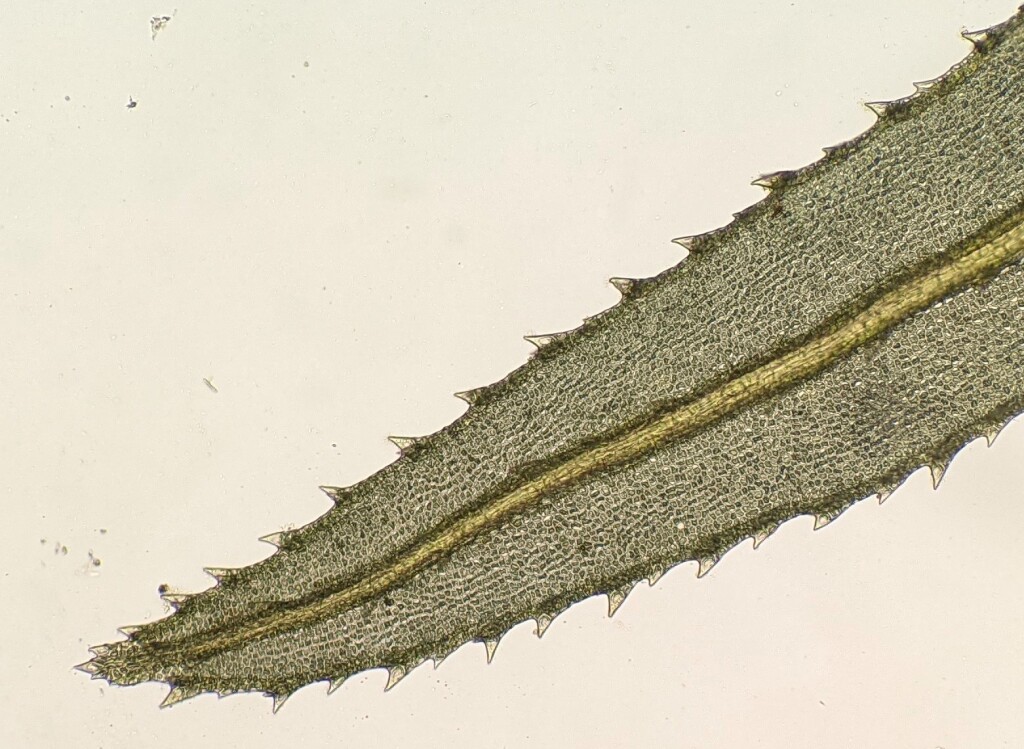Hymenodontopsis
Dioicous. Asexual propagules absent. Tufts or mats on soil, rocks, logs, tree and tree ferns trunks. Stems erect, simple or branched away from base, sometimes densely so (not in Victoria), tomentose in basal half or only at base; central strand present. Leaves ovate- (not in Victoria) to linear-lanceolate, arranged around stem and facing all directions or distichous and complanate on branches (not in Victoria), monomorphic or becoming noticeable smaller and scale-like at base of stem (not in Victoria) and smaller, asymmetric and more ovate on branches (not in Victoria), erect- to wide-spreading when moist, appressed (not in Victoria) or twisted and curled when dry; apex acuminate, without a hairpoint; costa strong, single, subpercurrent or percurrent, toothed abaxially; margins serrate, with paired teeth, with at least a partially bistratose border but cells not elongate; laminal cells mostly ±isodiametric, subquadrate or irregular, sometimes short-rectangular at base, smooth; alar cells not differentiated. Pleurocarpous, perichaetia and perigonia lateral on lower half of stem away from base. Capsules erect (not in Victoria) or inclined to horizontal, curved or straight (not in Victoria), cylindric, obovoid or cupulate (not in Victoria), with or without (not in Victoria) an annulus. Calyptra cucullate, smooth, glabrous. Operculum conic-apiculate (not in Victoria) or rostrate. Peristome double or single (not in Victoria); exostome absent (not in Victoria) or of 16 entire teeth; endostome of 16 segments, equal in length to exostome teeth, with a low (not in Victoria) or high basal membrane; cilia present or absent (not in Victoria).
Four species, one in South Africa, one in Malesia, one shared between New Zealand, New South Wales and Tasmania and a widespread species in south-eastern Australia, New Zealand and Andean South America.
Three former species of Pyrrhobryum, namely P. bifrarium (Hook.) Manuel, P. mnioides (Hook.) Manuel and P. vallis-gratiae (Hamp. In C.Müll.) Manuel were transferred to the previously monotypic Hymenodontopsis (Bell et al. 2007). This was done in response to a phylogeny of combined mitochondrial and chloroplast DNA sequences showing that these species were most closely related to H. stresemannii Herzog and that this genus is more closely related to Aulacomnium and the Aulacomniaceae than the Rhizogoniaceae (Bell et al. 2007). Hymenodontopsis stresemannii and the former Pyrrhobryum species that are now included in Hymenodontopsis are similar gametophytically and differ from Pyrrhobryum, except for P. dozyanum (Sande Lac.) Manuel (see Pyrrhobryum profile), as defined by molecular characters, by non-basal perichaetia, a lack of subperichaetial innovation, and production of vegetative branches distally (Bell et al. 2007). Hymenodontopsis stresemannii was previously regarded as distinct from all Pyrrhobryum based on its sporophyte which differs from the current and former Pyrrhobryum species by its erect, straight and cupulate capsule without an annulus and reduced peristome comprising an endostome, with a low basal membrane and without cilia.
 Spinning
SpinningBell, N.E.; Quandt, D.; O’Brien, T.J.; Newton, A.E. (2007). Taxonomy and phylogeny in the earliest diverging pleurocarps: square holes and bifurcating pegs. The Bryologist 110: 533–560.
